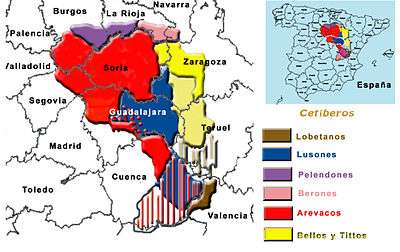Celtiberians
The Celtiberians were a group of Celts or Celticized peoples inhabiting the central-eastern Iberian Peninsula during the final centuries BC. They were explicitly mentioned as being Celts by several classic authors (e.g. Strabo[1]). These tribes spoke the Celtiberian language and wrote it by adapting the Iberian alphabet.[2] The numerous inscriptions that have been discovered, some of them extensive, have allowed scholars to classify the Celtiberian language as a Celtic language, possibly one of the Hispano-Celtic (also known as Iberian Celtic) languages that were spoken in pre-Roman and early Roman Iberia. Archaeologically, many elements link Celtiberians with Celts in Central Europe, but also show large differences with both the Hallstatt culture and La Tène culture.
There is no complete agreement on the exact definition of Celtiberians among classical authors, nor modern scholars. The Ebro river clearly divides the Celtiberian areas from non-Indo-European speaking peoples.[3] In other directions, the demarcation is less clear. Most scholars include the Arevaci, Pellendones, Belli, Titti and Lusones as Celtiberian tribes, and occasionally the Berones, Vaccaei, Carpetani, Olcades or Lobetani.[4]
Origin of the term
The term Celtiberi appears in accounts by Diodorus Siculus,[5] Appian[6] and Martial[7] who recognized intermarriage between Celts and Iberians after a period of continuous warfare, though Barry Cunliffe says "this has the ring of guesswork about it."[8] Strabo just saw the Celtiberians as a branch of the Celti.[1] Pliny the Elder thought that the original home of the Celts in Iberia was the territory of the Celtici in the south-west, on the grounds of an identity of sacred rites, language, and the names of cities.[9]
History
Early history

Strabo cites Ephorus's belief that there were Celts in the Iberian peninsula as far as Cadiz,[10] bringing aspects of Hallstatt culture in the 6th to 5th centuries BC, adopting much of the culture they found. This was a culture of seasonally transhumant cattle-raising pastoralists protected by a warrior elite, similar to those in other areas of Atlantic Europe, centered in the hill-forts, locally termed castros, that controlled small grazing territories. Settlements of circular huts survived until Roman times across the north of Iberia, from Northern Portugal, Asturias and Galicia through Cantabria and northern Leon to the Ebro River.[11]
Celtic presence in Iberia likely dates to as early as the 6th century BC, when the castros evinced a new permanence with stone walls and protective ditches. Archaeologists Martín Almagro Gorbea and Alvarado Lorrio recognize the distinguishing iron tools and extended family social structure of developed Celtiberian culture as evolving from the archaic castro culture which they consider "proto-Celtic".
Archaeological finds identify the culture as continuous with the culture reported by Classical writers from the late 3rd century onwards (Almagro-Gorbea and Lorrio). The ethnic map of Celtiberia was highly localized however, composed of different tribes and nations from the 3rd century centered upon fortified oppida and representing a wide-ranging degree of local assimilation with the autochthonous cultures in a mixed Celtic and Iberian stock.

The cultural stronghold of Celtiberians was the northern area of the central meseta in the upper valleys of the Tagus and Douro east to the Iberus (Ebro) river, in the modern provinces of Soria, Guadalajara, Zaragoza and Teruel. There, when Greek and Roman geographers and historians encountered them, the established Celtiberians were controlled by a military aristocracy that had become a hereditary elite. The dominant tribe were the Arevaci, who dominated their neighbors from powerful strongholds at Okilis (Medinaceli) and who rallied the long Celtiberian resistance to Rome. Other Celtiberians were the Belli and Titti in the Jalón valley, and the Lusones to the east.
Excavations at the Celtiberian strongholds Kontebakom-Bel Botorrita, Sekaisa Segeda, Tiermes[12] complement the grave goods found in Celtiberian cemeteries, where aristocratic tombs of the 6th to 5th centuries BC give way to warrior tombs with a tendency from the 3rd century BC for weapons to disappear from grave goods, either indicating an increased urgency for their distribution among living fighters or, as Almagro-Gorbea and Lorrio think, the increased urbanization of Celtiberian society. Many late Celtiberian oppida are still occupied by modern towns, inhibiting archaeology.
_01.jpg)
Metalwork stands out in Celtiberian archaeological finds, partly from its indestructible nature, emphasizing Celtiberian articles of warlike uses, horse trappings and prestige weapons. The two-edged sword adopted by the Romans was previously in use among the Celtiberians, and Latin lancea, a thrown spear, was a Hispanic word, according to Varro. Celtiberian culture was increasingly influenced by Rome in the two final centuries BC.
From the 3rd century, the clan was superseded as the basic Celtiberian political unit by the oppidum, a fortified organized city with a defined territory that included the castros as subsidiary settlements. These civitates as the Roman historians called them, could make and break alliances, as surviving inscribed hospitality pacts attest, and minted coinage. The old clan structures lasted in the formation of the Celtiberian armies, organized along clan-structure lines, with consequent losses of strategic and tactical control.
Late period
The Celtiberians were the most influential ethnic group in Iberia when the Mediterranean powers (Carthage and Rome) started its conquest. In 220 BC, the Punic army was attacked when preparing to cross the Tagus river by a coalition of Vaccei, Carpetani and Olcades. Despite these clashes, during the Second Punic War the Celtiberians served most often as allies or mercenaries of Carthage in its conflict with Rome, and crossed the Alps in the mixed forces under Hannibal's command. Under Scipio, the Romans were able to secure alliances and change the allegiances of many Celtiberian tribes, using these allied warriors against the Carthaginian forces and allies in Spain.
After the conflict, Rome took possession of the Punic empire in Spain, and some Celtiberians soon challenged the new dominant power that loomed in the borders of its territory. Tiberius Sempronius Gracchus spent the years 182 to 179 pacifying the Celtiberians; however, conflicts between various semi-independent bands of Celtiberians continued.
After the city of Numantia was finally taken and destroyed by Scipio Aemilianus Africanus the Younger, after a long and brutal siege that ended the Celtic resistance (154 – 133 BC), Roman cultural influences increased; this is the period of the earliest Botorrita inscribed plaque; later plaques, significantly, are inscribed in Latin. The Sertorian War, 80 – 72 BC, marked the last formal resistance of the Celtiberian cities to Roman domination, which submerged the Celtiberian culture.

The Celtiberian presence remains on the map of Spain in hundreds of Celtic place-names. The archaeological recovery of Celtiberian culture commenced with the excavations of Numantia, published between 1914 and 1931.
A Roman army auxiliary unit, the Cohors I Celtiberorum, is known from Britain, attested by 2nd century AD discharge diplomas.[13]
See also
Notes
- 1 2 Strabo. Geography. Book III Chapter 4 verses 5 and 12.
- ↑ Cremin, Aedeen (2005). "Celtiberian Language". In Koch, John. Celtic Culture: A Historical Encyclopedia. Volume I: A–Celti. Santa Barbara, CA: ABC-CLIO. pp. 363–364. ISBN 978-1-85109-440-0.
- ↑ Roman History, Book XVIII "Cato sailed away and reached Spain, where he learned that all the inhabitants as far as the Iberus (Ebro river) had united in order to wage war against him in a body. After organizing his army he attacked and defeated them and forced them to submit to him, since they feared that otherwise they might lose their cities at a single stroke. At the time he did them no harm, but later, when some of them incurred his suspicion, he deprived them all of their arms and caused the natives themselves to tear down their own walls. For he sent letters in all directions with orders that they should be delivered to everybody on the same day; and in these he commanded the people to raze their walls immediately, threatening the disobedient with death. The officials upon reading the letters thought in each case that message had been written to them alone, and without taking time for deliberation they all threw down their walls. Cato now crossed the Iberus, and though he did not dare to contend with the Celtiberian allies of the enemy on account of their number, yet he handled them in marvellous fashion, now persuading them by a gift of larger pay to change front and join him, now admonishing them to return home, and sometimes even announcing a battle with them for a stated day. The result was that they broke up into separate factions and became so fearful that they no longer ventured to fight with him."
- ↑ The Celts in Iberia: An Overview, e-Keltoi: Volume 6 https://www4.uwm.edu/celtic/ekeltoi/volumes/vol6/6_4/lorrio_zapatero_6_4.html
- ↑ Celtiberian manners and customs in Diodorus Siculus v. 33–34; Diodorus relies on lost texts of Posidonius.
- ↑ Appian of Alexandria, Roman History.
- ↑ Bilbilis was the birthplace of Martial.
- ↑ Cunliffe, Barry (2003). The Celts: a very short introduction. Oxford University Press. p. 52. ISBN 0-19-280418-9.
- ↑ Sir William Smith (1854), Dictionary of Greek and Roman Geography, Volume 2, Boston: Little, Brown and Company.
- ↑ Strabo (1923). The Geography of Strabo; with an English translation by Horace Leonard Jones. II, book IV, chapter 4 (Loeb Classical Library ed.). London: Heinemann.
- ↑ Koch, John, ed. (2005). "Iberian Peninsula, Celts on the". Celtic Culture: A Historical Encyclopedia. Volume I: A–Celti. Santa Barbara, CA: ABL-CLIO. p. 950. ISBN 978-1-85109-440-0. Retrieved June 9, 2010.
- ↑ The Site of Tiermes Archived January 12, 2005, at the Wayback Machine., official website
- ↑ Guy de la Bédoyère Eagles over Britannia: the Roman Army in Britain. Stroud: Tempus, 2001 ISBN 0-7524-1923-4; p. 241.
References
- Ángel Montenegro et alii, Historia de España 2 – colonizaciones y formación de los pueblos prerromanos (1200–218 a.C), Editorial Gredos, Madrid (1989) ISBN 84-249-1386-8
- Antonio Arribas, The Iberians, Thames & Hudson, London (1964)
- Francisco Burillo Mozota, Los Celtíberos, etnias y estados, Crítica, Barcelona (1998, revised edition 2007) ISBN 84-7423-891-9
- Barry Cunliffe, "Iberia and the Celtiberians" in The Ancient Celts, Penguin Books, London (1997) ISBN 0-14-025422-6
- Alberto J. Lorrio, Los Celtíberos, Universidad Complutense de Madrid, Murcia (1997) ISBN 84-7908-335-2
- Alberto J. Lorrio and Gonzalo Ruiz Zapatero, "The Celts in Iberia: an Overview" in e-Keltoi 6
- J. P. Mallory, In Search of the Indo-Europeans, Thames & Hudson, London (1989) ISBN 0-500-05052-X
- Jesús Martín-Gil, Gonzalo Palacios-Leblé, Pablo Martín-Ramos and Francisco J. Martín-Gil, "Analysis of a Celtiberian protective paste and its possible use by Arevaci warriors". e-Keltoi 5, pp. 63–76.
- J. Alberto Arenas Esteban, & Mª Victoria Palacios Tamayo, El origen del mundo celtibérico, Excmº Ayuntamiento de Molina de Aragón (1999) ISBN 84-922929-1-1
External links
![]()
| Wikisource has the text of the 1911 Encyclopædia Britannica article Celtiberia. |
- Júdice Gamito, Teresa (September 2005). "The Celts in Portugal". e-Keltoi. Center for Celtic Studies, University of Wisconsin-Milwaukee. 6: The Celts in the Iberian Peninsula: 571–605.
- Lorrio, Alberto J.; Ruiz Zapatero, Gonzalo (February 2005). "The Celts in Iberia: An Overview". e-Keltoi. Center for Celtic Studies, University of Wisconsin-Milwaukee. 6: The Celts in the Iberian Peninsula: 167–254.
- Rodríguez Ramos, Jesús (March 17, 2006). "Iberian Epigraphy Page". Archived from the original on December 27, 2008. Retrieved 2008-11-29.
- "Botorrita 1". Quellentexte (in German). Vienna: *indegermanistik wien: Institutsteil des Instituts für Sprachwissenschaft der Universität Wien. 2002. Archived from the original on September 29, 2009. Retrieved November 30, 2008.
- Almagro-Gorbea, Martín; Lorrio, Alberto J. (October 2004). "War and Society in the Celtiberian World" (PDF). e-Keltoi. Center for Celtic Studies, University of Wisconsin-Milwaukee. 6: The Celts in the Iberian Peninsula: 73–112.
- James Grout: The Celtiberian War, part of the Encyclopædia Romana
- Detailed map of the Pre-Roman Peoples of Iberia (around 200 BC)
